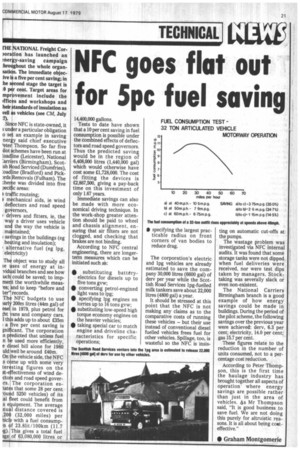NFC goes flat out for 5pc fuel saving
Page 23

If you've noticed an error in this article please click here to report it so we can fix it.
NATIONAL Freight Cor)ora ion has launched an mer y-saving campaign :hroi4ghout the whole organsati n. The immediate objecive 14i a five per cent saving; in he ond stage the target is .0 pr cent. Target areas for mpr vement include the Iffic s and workshops and heir tandards of insulation as yell s vehicles (see CM, July Si e NFC is state-owned, it uni era particular obligation o se an example in saving ner y said chief executive 'ete Thompson. So far five ilot chemes have been run at toad Me (Leicester), National :am rs (Birmingham), Scotsh oad Serviced (Dumfries), :oad Me (Bradford) and Pick)rds Removals (Fulham). The the e was divided into five eci lc areas: tr routeing; m chanical aids, ie wind de lectors and road speed go ernors, d vers and fitters, ie, the wa1 a driver uses vehicle an the way the vehicle is ma ntained.
sa ings in the buildings (eg he ting and insulation); al ernative fuel (eg lpg, ele tricity) Th object was to study all ie ses of energy at invid al branches and see how uch could be saved; to impme t the worthwhile meas'es; Ind to keep "before and ter' records.
Th NFC budgets to use !arl 200m litres (44m gal) of esel in 1979, plus petrol for ht ans and company cars. I th s adds up to about £35m a ive per cent saving is gni cant. The corporation s p edicted that unless fuel n used more efficiently, e d esel bill alone for 1980 uld ell be around £40m. On he vehicle side, the NFC s c me up with some very ter sting figures on the st-e fectiveness of wind decto s and road speed gover,rs. The corporation es • s that some 28 per cent .ou d 5250 vehicles) of its al eet could benefit from s e uipment. The average flu,! distance covered is ,20 (32,000 miles) per ilcl with a fuel consumpf 23.81it/100km (11.7 ig). This gives a total fuel ige of 63,080,000 litres or 14,400,000 gallons.
Tests to date have shown that a 10 per cent saving in fuel consumption is possible under the combined effects of deflectors and road speed governors. Thus the predicted saving would be in the region of 6,408,000 litres (1,440,000 gal) which would otherwise have cost some £1,728,000. The cost of fitting the devices is £2,887,500, giving a pay-back time on this investment of only 1.67 years.
Immediate savings can also be made with more economical driving technique. In the work-shop greater attention should be paid to wheel and chassis alignment, ensuring that air filters are not clogged, and checking that brakes are not binding.
According to NFC central engineering, there are longerterm measures, which can be initiated such aS: • substituting battAryelectrics for diesels up to five tons gvw; • converting petrol-engined light vans to lpg; • apecifying lpg engines on lorries up to 16 tons gvw; • substituting low-speed high torque economy engines on the heavier vehicles; • taking special car to match engine and driveline characteristics for specific operations; • specifying the largest practicable radius on front corners of van bodies to reduce drag.
The corporation's electric and lpg vehicles are already estimated to save the company 30,000 litres (6600 gal) of dery per year while the Scottish Road Services lpg-fuelled milk tankers save about 22,000 litres (4800 gal) a year.
It should be stressed at this point that the NFC is not making any claims as to the comparative costs of running these vehicles — but their use instead of conventional diesel fuelled vehicles frees fuel for other vehicles. Spillage, too, is wasteful so the NFC is insis ting on automatic cut-offs at the pumps.
The wastage problem was investigated via NFC internal audits. It was found that some storage tanks were not dipped when fuel deliveries were received, nor were test dips taken by managers. Stocktaking was severally slack or even non-existent.
The National Carriers Birmingham branch is a good example of how energy savings could be made in buildings. During the period of the pilot scheme, the following savings over the previous year were achieved: derv, 6.3 per cent; electricity, 14.0 per cent; gas 15.7 per cent.
These figures relate to the reduction in the number of units consumed, not to a percentage cost reduction.
According to Peter Thompson, this is the first time the haulage industry has brought together all aspects of operation where energy savings are possible rather than just in the area of vehicles. 4s Mr Thompson said, "It is good business to save fuel. We are not doing this purely for altruistic reasons. It is all about being costeffective."
• Graham Montgomerie








































































































